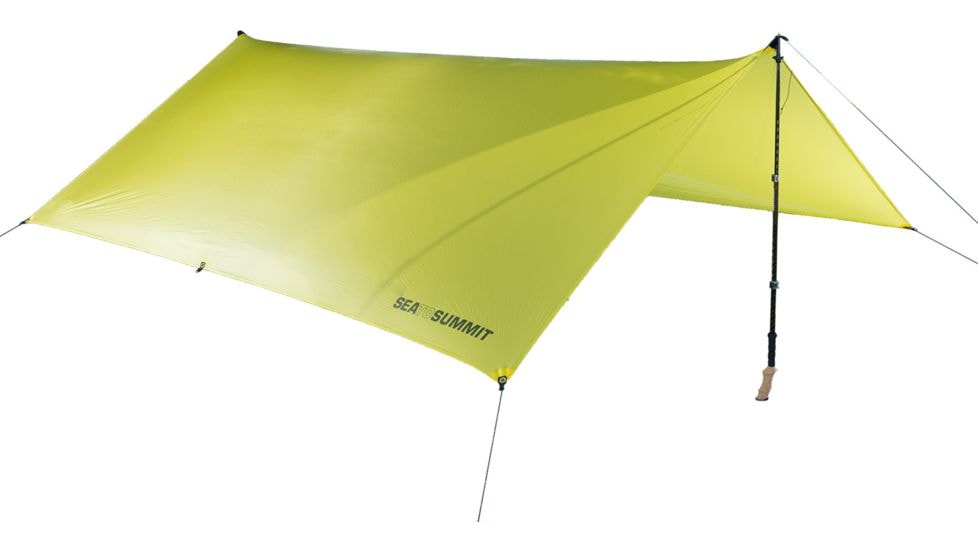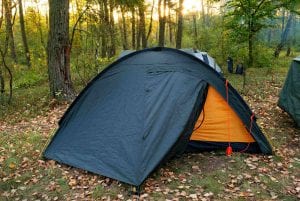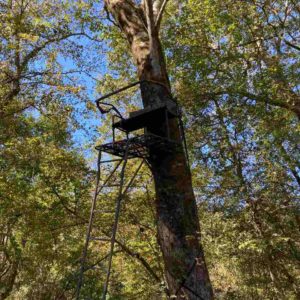You’d be surprised at the huge range of camping tarps there are out there…!
- You may be looking for the best tarp for backpacking: a super-sturdy but extremely lightweight shelter to camp under.
- Or you could be looking for something a bit simpler to act as a sunshade or rain shelter or awning for when you’re not in your tent.
- Or you could be looking for a groundsheet-type-tarp to sub in for a picnic blanket or use as a tent footprint.
We spent 20 hours looking through all the different options for this article. So regardless of your budget or what you want to use it for, we’re confident you’ll find the best camping tarp for your needs in the recommendations below.
Welcome to the weird and wonderful world of camping tarps!
- The Santuary SilTarp is a seriously good all-round camping tarp. Use it for backpacking or as a sunshade… You get a complete kit at a great price!
- Free Soldier camping tarps are large and excellent value. Cheaper than the Santuary SilTarp but also heavier.
- Sea to Summit “Escapist” is hands down the best backpacking tarp out there: ultralight, compact & strong.
- RedCamp’s camping tarps are super basic & super cheap. Not ideal for backpacking but OK for most other things.
Sanctuary SilTarp Review – Best Camping Tarp

Specs
The Santuary SilTarp is made with 30 denier ripstop nylon and comes in a range of sizes starting at 10′ x 8′ and going all the way up to 12′ x 10′. You can also choose from a range of cuts, including tapered, flat and hex. Attachment points vary with the size, ranging from 12 to 16. And the weight also varies, starting at just 14oz for the smallest camping tarp. ($$$)
The Verdict
One of the great things about the Sanctuary SilTarp is, whatever size and shape you buy, they all come as complete kits so you don’t have to worry about buying any extras. As well as your camping tarp you get guy lines, adjusters, stakes and a compression sack.
They also have a generous number of attachment points allowing for loads of set up configurations. So you aren’t going to feel limited when you take this into the wilds.
The silicon/PU treatment and taped seams make them exceptionally waterproof and durable. Added to which they come with a lifetime guarantee, which I always see as a huge mark of confidence from the manufacturer.
One thing I did notice is that the stakes can leave a bit to be desired. It’s a personal bugbear of mine that whenever stakes are included as part of a bundle they tend to be somewhat sub-par. If you don’t like them, though, you can always replace them with your own (or you could check out my reviews of the best tent stakes for recommendations).
In Summary…
This is a great choice if you are looking for a a really versatile camping tarp. It’s lightweight enough to use for backpacking or for a temporary hiking shelter. It’s also a great shelter against sun and rain at a base camp. Can’t recommend it enough!
Free Soldier Tarp Review – Best Cheap Camping Tarp

Specs
The Free Soldier camping tarp is 10′ x 11′ (flat-cut). You have 6 different colors to choose from. All variations have 10 attachment points and weigh 2lbs 3oz. They also all come as a complete kit with guy lines. ($)
The Verdict
If you’re looking for an awesome 2-person camping tarp and you don’t want to spring for the largest Sanctuary SilTarp, then this is a really great option at a cheaper price point.
The 10 tie outs offer lots of set up configurations, meaning you should be able to set it up even the most awkward locations. It also comes with decent cord for suspension and a stuff-sack.
Unlike a lot of backpacking tarps you can also close the ends for added wind & rain protection, which is great if you’re planning a camping trip in poor weather conditions because it means your head, feet and gear are less likely to get wet.
It’s heavily stitched which gives you a lot of confidence about it holding up in the wind and rain. I also thought the orange trim along the edges is a really nice touch, helping keep the tarp visible in low light and thick coverage.
As with most camping tarps, it doesn’t come with tarp poles, so you may want to factor that into your budget. The stuff sack is a little on the small side meaning it can be a bit fiddly to pack up. And it’s definitely a heavier than some of the best camping tarps I’ve used, so if you’re a lightweight-gear-junkie this may not be for you.
In Summary…
This camping tarp is big, fairly heavy, tough and inexpensive. It’s probably best suited to folks who don’t mind a bit of bulk and weight: car campers on a budget or backpackers who enjoy tarp camping (but don’t do it a weight-saving exercise). A solid thumbs up!
Alternatives
If you don’t mind paying a bit more, then you might also be interested in Aqua Quest. The Aqua Quest Defender is a similar size but better spec. And the Aqua Quest Safari is a lovely large but light design.
Sea to Summit Escapist Review – Best Backpacking Tarp

Specs
The “Escapist” from Sea to Summit is a flat-cut backpacking tarp made from 15D Ultra-Sil Nano. It comes in 2 sizes: Medium (8′ x 6′) and Large (10′ x 10′). The Medium tarp weighs 10.5oz and the Large weighs 15.5oz. Both have 8 tie outs which are ‘bartacked’ to hold the tip of trekking poles. ($$$$)
The Verdict
In all our research this was hands down the best backpacking tarp we could find.
It is expensive, so if cost is a major consideration you may want to look elsewhere. But if you’re looking for the strongest, most compact, ultralight tarp on the market, you need look no further.
Unlike some of the camping tarps discussed here, this does not come as a complete kit. You will get no guy lines or stakes included (although it does comes with a stuff sack). But that’s fine because you’ll probably want to use your own cord and stakes anyway.
While Sea to Summit claim you can sleep comfortably under the medium sized version, I’d probably take issue with that. It’s certainly possible but if it rains there’s a good chance either your head or your feet will get wet. It’s probably best used as a day-hiking shelter or an emergency shelter.
For backpacking, you probably want to spring for the 10′ x 10′ tarp. Two reasons, really: 1) you’re less likely to let the elements in than with the smaller version and 2) it integrates perfectly with the Escapist Inner Bug Net. So for a few extra ounces, there’s a good chance you’ll stay dry and bug free. That is certainly a trade off I’m willing to make!!
In Summary…
If you’re looking for a tarp that’s light, compact and durable this won’t disappoint! This is the best backpacking tarp I know of and perfect for thru-hiking.
Aqua Quest Defender Tarp Review – Best Bushcraft Tarp

Specs
When it comes to the Aqua Quest Defender you’ve got 4 sizes to choose from (10×7, 10×10, 13×10 or 15×15) and 2 colors (cammo or olive drab). It’s flat-cut with 21 re-enforced webbing loops. It’s exceedingly durable, weighs less than 2lbs and is relatively inexpensive. ($$)
The Verdict
Aqua Quest are pretty bombproof as camping tarps go. That means it is quite heavy, yes, but you can really feel the quality as soon as you lay hands on it. The 70D nylon has a hefty waterproof coating on it and the stitching is heavily re-enforced. It’s backed with a 2-year, no-quibbles warranty which always goes a good way towards understanding how much faith the manufacturer has in their products.
The plethora of web loops is well-thought-out. It makes the tarp extremely versatile. It’s really easy to pitch for a sleeping setup. Equally, if you are in a tent then it makes an excellent additional cover either for your tent or as a canopy for a camp kitchen.
Because it’s as heavy as a small tent, the ultralight crew are unlikely to be interested in the Defender for backpacking (although it’s worth noting Aqua Quest have a lighter version (the Aqua Quest Safari) which you can check out here). But because of it’s durability I can really see it appealing to anyone into bushcraft or survival.
In Summary
If you’re looking to save weight, you might want to look at the Aqua Quest Safari or the Sea to Summit Escapist tarp or the MSR Thru Hiker. If you enjoy tarp camping and want something than can withstand a beating (and then some), it is an awesome piece of kit!
Kelty Noah’s 9 / Kelty Noah’s 12 Review

Specs
The Kelty Noah’s Tarp 9 is 9′ x 9′ while the Kelty Noah Tarp 12 is… wait for it… 12′ x 12′! They are both cat-cut camping tarps (mostly square but with curved edges for extra tautness) with 12 attachments. Both weigh in around 2lbs (Kelty 9 is less than 2lbs, the 12 is a touch over). Rated for 3 seasons. Includes stakes and a carry bag. ($$$)
The Verdict
Kelty Noah’s tarps are lightweight and very well-designed, as anyone familiar with Kelty would expect. Both tarps come with two grommets to make it super-easy to use with extendable tarp poles if that’s your bag (Kelty sell poles separately – they are well-priced and good quality).
The abundance of attachment points makes it extremely versatile and therefore a great all-rounder! So whether you are looking for a tarp to go thru-hiking or just looking for a stable sun shade at a festival or car camping (or indeed any camping trip), this is probably going to deliver for you.
The catenary cut should mean most people can get it extremely taut. But at the same time, it might also mean some people find it a bit difficult to set up for the first time. The seams may benefit from additional water protection.
In Summary…
Both sizes provide great coverage at a good weight and a decent price for all camping trips. The versatility means it’s an excellent choice for a wide range of uses. It gets a big thumbs up from us!
RedCamp – Best Basic Camping Tarp


Specs
RedCamp offer a variety of options and bundles. Some are square, others rectangular, all are under 10′ on the longest side. They are made of 210D ripstop poly. You can pick up a standalone camping tarp or you can get a bundle which comes with guy lines and stakes. They comes with 4 grommets; one in each corner. ($)
The Verdict
This is far and away the cheapest camping tarp covered in this article. It’s clearly very popular and has lots of rave reviews on Amazon.
However, before you get too excited, although this is a multi purpose tarp, they definitely have their limitations.
First off, I favor a 10×10 camping tarp. Some folks might be willing to go smaller. But every single option from RedCamp is significantly smaller. For this reason I’m just not convinced they give sufficient coverage when used as a rain fly. As a small sunshade? Sure. But as a backpacking shelter? No.
Secondly, with only 4 grommets, you’re really lacking the ability to configure it as a rain fly unless you have 4 conveniently-spaced anchor points.
What they are pretty good at is as groundsheets. So if you need a floor in a backpacking shelter or if you’re looking for a tent footprint, then this is a fairly solid purchase. I also reckon that it will do you just fine as a shelter for camping trips in pleasant weather conditions. So fine as a sunshade. Less good in heavy rain.
In Summary…
If you are looking for a very basic camping tarp, then you can buy one of these without worrying too much about wasting your hard-earned dollars, they’re that cheap. You may well have to replace it after a season but they’re great for occasional use, especially as a groundsheet or footprint.
Alternatives
If I was looking for a cheap rain fly, I’d probably spend a few more dollars and roll with the Free Soldier. It’s bigger and more durable.
How To Choose a Camping Tarp
There’s quite a lot of variety in the marketplace. And so we’re going to try and break everything down to make it easier for you to navigate the choices. Whether you want to use a camping tarp as a shelter to sleep under or as a canopy to shelter from the elements, we’ve got you “covered” (#MegaLolz).
Your key considerations:
- Size Matters: Packed size can’t be too bulky if you need it to be portable and the coverage needs to be sufficient for your intended use.
- Weight: If you plan to hike with a tarp, your back will thank you for going light.
- Shape & Design: Square tarp vs Rectangular tarp vs Cat Cut tarp (whut?)… Understand the pros and cons of different shapes.
- Material: Do you need a top-tier fabric? Or will a basic tarp be adequate?
- Colors: Hi-vis? Or a sneaky Forest Green?
- Functionality: Do you need something multi-functional? Or do you have a single purpose in mind?
Because tarps have such a wide variety of uses (groundsheet, makeshift tent, impromptu rain cover to name a few) you just need to ask yourself if you want to tarp to do anything above and beyond its standard tarp duties.
Will you want to rig it as a makeshift shelter on a hike? Might you want to stake it down as a windbreak? Should it be big enough to roll all your children up in if they get on your nerves during school holidays?
When you know the answers to those questions, consider these factors:
What Size Tarp for Camping?
Choosing the right size of tarp is important and to do that, it’s best to know in advance how you’re planning on using it.
A standard square tarp is 10′ x 10′. This will offer a reasonable canopy for a camp kitchen. A small family of 3-4 can eat meals under it. It will provide decent cover for a small group in a rainstorm. One person can sleep under it with their gear. (DD Tarps have a rock solid 10×10 option. Good price. Not very heavy. Great all-rounder).
Kick it up a gear and you’ve got tarps with some extra square footage. If you’re looking for a rain shelter, 10×10 can get a bit cramped as you pull down the sides and batten down the hatches. You might find a 12’/13′ tarp better, then, for wet weather camping and for slightly larger families/groups. (Aquaquest have a solid 10’x13′ option and Kelty have a nice catenary-cut product called Kelty Noah’s Tarp in various sizes, available on Amazon or direct from their website).
Getting into the 15′ and 20′ range is probably only something you’d want as part of a very large group; perhaps a scout leader or 2+ families camping together. They start to get quite bulky and heavy in this range. But obviously if you need the space then you need the space!
Shape and Design
You’d be forgiven for thinking a tarp is a tarp, but believe it or not, there are actually a few different shapes and designs on offer, each suited to different needs. Let’s take a look now.
Square Tarps
Square tarps are the most classic and versatile option for campers. The generous sizing provides a ton of room to spread out and means the tarp can do double duty as a vehicle cover.
However, large square tarps might be inefficient for a solo adventurer because of the bulk and weight.
Rectangular Tarps
Popular among solo hikers. Because the length is greater than width, they make nifty bivouacs that are ideal for one person. Don’t go too narrow to save weight because the narrower the tarp, the higher is the risk of rain splatter or weather that’s too adventurous!.
Tapered tarps are a variant, these are narrower at the foot compared to the head. They provide enough space but restrict overall weight. Technically, tapered tarps are more efficient but this comes at a price — prepare to pay more than your standard rectangle tarp.
Cat-Cut Tarps
With delicate curves along the sides and ridges, cat-cuts tarps provide perfect tautness with minimal effort. If you’re over floppy edges, consider a cat-cut, named for catenary cuts that prevent flapping. An added bonus is the reduced noise.
Despite these benefits, you do have to fully pitch a cat-cut tarp. For this reason, they’re not really suitable in dense woodlands or any place where the trees are close together. As with tapered tarps, expect to pay a premium price for these models.
Asymmetrical Tarps
These are pretty niche and are primarily designed to work with asymmetrical hammocks. If you’ve ever slept in a hammock you’ll know that you’re quite open to the elements, even with a tarp up top. For that reason, asymmetrical tarps aren’t very popular.
What Is The Best Tarp Material?
A camping tarp’s material should be waterproof so water won’t seep through. You want to prevent dampness and shelter your supplies.
Durability, in addition to water resistance, is the key quality you want in a tarp’s material. Better durability prevents rips and means you won’t have to shop for a replacement. And, of course, durable materials withstand extreme weather conditions well.
Tarps are available in a range of materials but these are the most popular:
Silpoly
Silpoly is polyester with infused silicone, the material is lightweight and waterproof. It’s the lightest fabric at a reasonable cost. For many happy campers, it’s the perfect blend of affordability and durability.
Cuben Fiber
The lightest tarp material available and beloved of ultralight backpackers. Cuben fiber (aka Dyneema Composite Fabric or DCF) is heat-welded and has stronger seams than other materials. If you go down this route, you won’t have to seam seal your tarp.
The only downside is the cost — cuben fiber is expensive. Plus it’s more vulnerable to punctures when taut.
Silnylon
Silnylon is crafted from silicone and polyester. Like silpoly, it’s durable and waterproof. Silnylon is significantly heavier than cuben fiber and a little heavier than silypoly. Both silpoly and silnylon tarps need seam sealing to prevent leaks.
Alternatively, concrete canvas is growing in popularity. It’s easy to use, flexible, and waterproof.
Weight
Although almost all tarp materials are durable, heavier tarps are less prone to rips and tears. If you’re carrying your tarp in a backpack, choose one that’s light enough that it won’t cause any slipped vertebrae over the course of a hike.
Lightweight tarps are handy when you’re camping with loads of equipment already.
Colors
While color isn’t of key importance, note that brighter shades reduce UV degradation by reflecting sunlight and darker colors let less light through the tarp’s material.
Functionality
It’s safe to say that how to choose a tarp is largely a matter of how you’ll use a tarp!
Hi-tech, super-strong materials help you make the most of your tarp. Multifunctional tarps, such as classic square, can be used to cover equipment, as a tent base, to block wind, and create a tent.
If you’re a single camper and you want a tarp as a groundsheet or to shelter under., consider a small, light rectangle. Overall, the lighter the better. However, if you’re driving instead of hiking, you can afford extra weight and might prefer a specialized, heavy tarp.
Tarps & Survival
There’s a very good reason that all good bug out backpacks will have a tarp in them. It’s not just that they are a lightweight, portable shelter. It’s the fact that they are so darned versatile! Use them as temporary cover on the move, as a groundsheet or to keep important stuff like firewood dry. In fact, if you’re a prepper, you won’t just want one survival tarp, you’ll probably want several!
If, after all this, you’ve decided that a rain tarp isn’t actually for you, don’t forget to check out my reviews of the best 1 person tents and the best 3 person tents as viable alternatives to tarp shelters.
Alternatively, if you’ve gone the other way and decided to use a hammock, read my reviews of the best hammock tarps.
FAQs
What Type of Tarp for Camping?
It can be difficult to navigate what type of tarp to use for camping; there are many different shapes and materials to choose from. The simplest type of tarp to choose though, is a 10′ x 10′ square tarp made from silnylon like the Sanctuary SilTarp…
What Is the Best Tarp Material?
The best tarp material largely depends on what you’re using the tarp for! For sleeping under when backpacking, cuben fiber is very popular. For a general camping shelter, you probably want silnylon. As an outdoor covering for furniture, polyester is fine.






